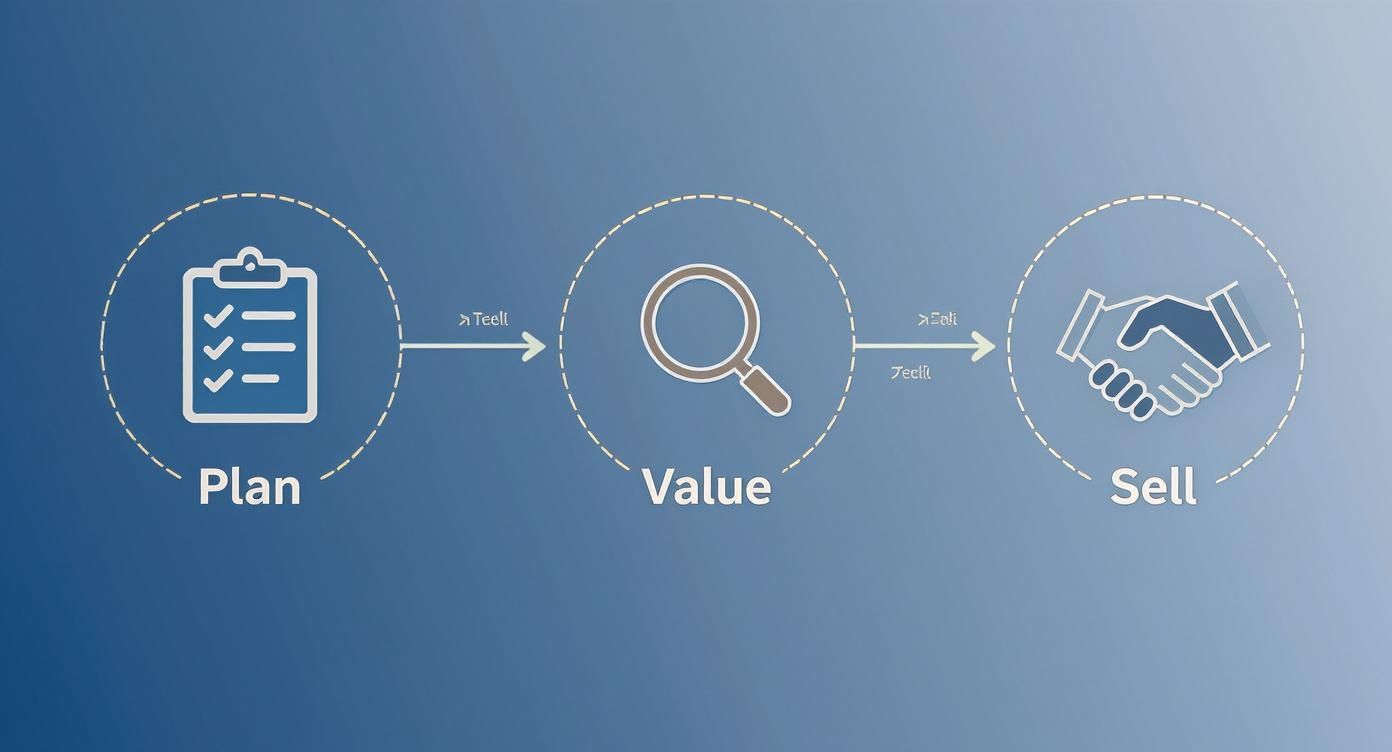Transferring a business you've poured your life into is a monumental step, mixing significant financial decisions with your personal legacy. Planning for this transition can feel overwhelming, but with the right legal guidance, it doesn't have to be. A smooth transition requires a solid strategy grounded in Texas law, moving from initial planning and objective valuation to a legally sound transfer that protects what you've built.
Laying the Groundwork for a Successful Transfer
Deciding to hand over the reins of your business is one of the biggest moments of your professional life. Whether you're eyeing retirement, pursuing a new venture, or passing the torch to the next generation, a carefully thought-out plan is the bedrock of a positive outcome.
This first stage is about more than just finding a buyer. It's about getting your business, your finances, and your family ready for what’s next. Before making any significant moves, you must be clear about your decision, your reasons, and the right timing. Market conditions, your personal situation, and your financial readiness all play a crucial role. A well-prepared exit strategy protects the value of your business and ensures continuity for your employees and customers.
The Three Pillars of a Business Transfer
Every transfer, no matter how complex, rests on three foundational pillars: strategic planning, an accurate valuation, and a legally sound sales process. Each piece builds on the one before it, creating a clear path forward.
This infographic provides a visual overview of the core process.

As you can see, a successful transfer starts long before any handshake. It begins with proactive planning and an objective valuation to set the stage for a smooth transaction.
The initial steps are often the most critical and can feel overwhelming. You’ll be organizing financial records, reviewing operations, and defining your personal and professional goals for the transition. For many entrepreneurs, this is where business succession becomes deeply personal—it's about your legacy.
A well-structured business transfer should be a cornerstone of your overall financial and personal legacy. Integrating this process with your personal estate plan ensures that your assets are protected and your wishes are honored, providing security for both your business and your loved ones.
It’s crucial to weave your business succession into your bigger financial picture. Thoughtful estate planning for small business owners can help you manage tax implications, protect your assets from future liabilities, and ensure wealth passes seamlessly to your beneficiaries.
Working with a Texas estate planning attorney can help align your business exit strategy with your long-term family and financial goals. This approach ensures every piece works together, giving you the clarity and confidence you need as you move toward your next chapter.
Every business transfer follows a predictable path. Understanding these key stages helps demystify the process and provides a clear roadmap from start to finish.
Key Stages of Business Ownership Transfer
| Stage | Key Objective | Primary Activities |
|---|---|---|
| Phase 1: Pre-Sale Planning | Prepare the business and owner for the transition. | Defining goals, organizing financials, assembling an advisory team (attorney, CPA). |
| Phase 2: Valuation & Marketing | Determine the business's fair market value and find potential buyers. | Performing a formal business valuation, creating marketing materials, confidentially identifying buyers. |
| Phase 3: Negotiation & Due Diligence | Agree on terms and allow the buyer to verify information. | Negotiating the Letter of Intent (LOI), buyer conducts a thorough review of financials and operations. |
| Phase 4: Closing & Transition | Finalize the legal transfer and ensure a smooth handover. | Signing the definitive purchase agreement, transferring funds, executing the transition plan. |
By breaking the transfer down into these manageable stages, what seems like a massive undertaking becomes a series of logical, achievable steps.
Determining Your Business's True Value
Before creating an exit plan, you need an objective, realistic number for what your business is worth. Attempting to transfer ownership without a clear valuation is like navigating the Gulf without a compass—you risk leaving money on the table, creating tax complications, and potentially breaching your legal duties under Texas law.
An accurate valuation is the bedrock of any successful transfer. It provides the foundation for negotiating a fair price, structuring a tax-efficient deal, and ensuring all parties are treated equitably. This isn’t about a number that feels right; it’s about a defensible figure grounded in solid financial principles.
Common Valuation Approaches in Texas
In Texas, there is no single "right" way to value a business. Experienced professionals use a combination of methods to obtain a comprehensive picture. To determine your business's true worth, it's important to understand the different approaches. For a deeper dive, you can explore the comprehensive details on business valuation methods and techniques to better understand these financial tools.
Let's break down the three main approaches in plain English:
- Asset-Based Approach: This is the most straightforward method. You add the value of all company assets—machinery, real estate, inventory—and subtract all its liabilities, like loans and debts. While clean, it often misses intangible assets like brand reputation or the loyal customer base you spent years building.
- Market-Based Approach: Similar to pricing a house, this method involves looking at what comparable businesses in your industry and area have recently sold for. It’s a powerful, real-world check, but its accuracy depends on the availability of comparable sales data.
- Income-Based Approach: This method focuses on the future. It projects your business's likely future earnings or cash flow to determine its present-day value. For profitable, established companies, this is often the most important metric.
Each method provides a different piece of the puzzle. Relying on just one can give you a dangerously skewed view of your company's value.
A Real-World Houston Example
Let’s imagine a manufacturing company in Houston. The owner is preparing for retirement and needs to know the company's value to begin succession planning—a critical part of our asset protection services.
- An Asset-Based valuation might estimate the value of the machinery, factory, and inventory at $3 million.
- A Market-Based analysis of similar local manufacturing firms that sold recently could suggest a value closer to $4.5 million.
- Finally, an Income-Based approach, projecting future profits, might produce a valuation of $5 million.
These numbers vary significantly. A professional appraiser wouldn't just pick the highest one. They would analyze all three, weigh each based on the company's specific situation, and arrive at a blended, defensible final figure. This objective number is crucial for every subsequent step.
The valuation process isn't just about finding a price tag. It's about building a credible, evidence-based case for your company's worth that will hold up under scrutiny from buyers, the IRS, and even family members in a transfer.
Why a Professional Valuation Is Non-Negotiable
Attempting to value your own business is one of the costliest mistakes you can make. Bringing in an experienced, third-party appraiser adds objectivity and credibility that you cannot replicate. Their formal report is a vital document that carries significant weight.
- It supports your asking price during negotiations.
- It provides justification for the sale price to tax authorities like the IRS.
- It ensures fairness and transparency in family successions or employee buyouts.
- It fulfills your fiduciary duties if the business is part of a trust or an estate, as required by the Texas Trust Code.
Investing in a professional valuation is not an expense; it's a critical step in protecting your financial future and legacy. It shifts the conversation from subjective opinions to objective facts, paving the way for a smooth and successful ownership transfer. It's a foundational piece of any smart estate planning strategy involving a business.
Structuring the Transfer for Legal and Financial Success

Once you have a firm valuation, the next critical question is how you will transfer the business. This decision is as important as the sale price. The deal's structure will shape everything—from your tax bill and future liability to the legacy of the company you built.
This is where we move beyond a simple sale to explore strategic options available under Texas law. Making the right choice is about protecting your financial interests and ensuring the outcome aligns with your personal and family goals. This is where professional legal guidance from a Texas trust administration lawyer becomes invaluable.
Stock Sales Versus Asset Sales
When selling to a third party, the discussion almost always comes down to two paths: a stock sale or an asset sale. They might sound similar, but the consequences for both buyer and seller are vastly different, especially regarding taxes and lingering legal liabilities.
A stock sale is exactly what it sounds like: you sell your ownership shares in the company. The buyer takes over the entire legal entity—assets, liabilities, contracts, and employees. For sellers, this is often the cleaner route and can result in more favorable tax treatment, typically long-term capital gains on the profits.
On the other hand, an asset sale means the buyer selects specific assets to purchase, such as equipment, inventory, client lists, or real estate. The original business entity remains with you, along with any liabilities the buyer did not explicitly assume. Buyers often prefer this because they can sidestep unknown liabilities and get better tax benefits through asset depreciation.
Choosing between a stock and asset sale is a pivotal moment with massive legal and financial ripple effects. A Texas estate planning attorney can model the outcomes of each structure, helping you pick the one that best protects your assets and minimizes your tax obligations.
For instance, a retiring owner of a Dallas IT firm might lean toward a stock sale for its simplicity and tax advantages. The buyer, however, might push for an asset sale to avoid potential liabilities from past service contracts. Negotiating this single point is a significant part of finalizing the deal.
Tailored Arrangements for Legacy and Continuity
Not every business transfer is about selling to the highest bidder. For many owners, the priority is preserving the company’s culture and rewarding those who helped build it. In such cases, powerful tools are available to ensure the legacy continues.
Two of the best options include:
- Management Buyouts (MBOs): In an MBO, your existing management team pools its resources to buy the business from you. This is an excellent way to ensure continuity, as the new owners already understand the company's operations and culture. These can be structured with seller financing, where you loan the management team part of the purchase price, creating a path to ownership for them and a steady retirement income stream for you.
- Employee Stock Ownership Plans (ESOPs): An ESOP is a specialized employee benefit plan that allows your team to become owners. You sell your shares to a trust, which holds them on behalf of the employees. It’s an incredible tool for motivating your team and can come with significant tax advantages for you as the seller.
These paths are more complex than a straightforward sale but offer unmatched benefits for owners focused on their company's future as much as their own.
Integrating the Transfer with Your Estate Plan
For family-owned businesses, the transfer is deeply intertwined with your overall estate planning. How you pass the business to the next generation can impact family harmony, tax liabilities, and the company's long-term health.
A well-crafted succession plan might use trusts to hold business interests, creating a smooth transition of control while shielding assets from creditors or future marital disputes. Gifting strategies over several years can also be used to transfer ownership gradually, minimizing potential gift and estate taxes. This kind of proactive planning is a cornerstone of our asset protection services.
Looking at the bigger picture, mergers and acquisitions (M&A) are the dominant force in business transfers. The IMAA Institute reported that M&A deals topped $1.2 trillion worldwide in just the first half of 2025, with mid-market deals accounting for almost 40% of that total. You can explore some of the 2025 top global M&A deals to see how these trends highlight the need for professional, structured transfers. Whether it’s a large-scale M&A or a carefully planned family succession, getting the structure right is everything.
Navigating a Family Business Succession
Passing a business down through the family involves more than just finances. It brings emotions, lifelong relationships, and the idea of legacy into sharp focus. This delicate process requires a thoughtful approach that balances the practical needs of the business with complex family dynamics.
A handshake agreement over Sunday dinner is not a plan; it’s a recipe for future misunderstandings and conflict.
The foundation of any successful family transfer is a formal, written succession plan. This document is your roadmap, spelling out exactly how and when the transition will occur, who will take the reins, and how the transfer will be structured. Without this clarity, you risk not only the business you built but also the family relationships you cherish.
Equity Over Equality
One of the most challenging conversations in any family succession revolves around fairness. While it's natural for parents to want to treat their children "equally," in a business context, equal is rarely equitable. Gifting identical ownership shares to a child who has dedicated their career to the company and another who has pursued a different path can breed resentment and create operational chaos.
True fairness means treating your children equitably based on their unique contributions, interests, and future roles.
- Active vs. Passive Roles: A child actively running the business might receive voting shares, giving them control. A non-involved child could receive non-voting shares or other estate assets to balance the inheritance.
- Defining Future Leadership: Your plan must name the next leader based on skill, dedication, and experience—not just birth order. This decision can prevent years of power struggles.
- Financial Balancing: You can use other assets in your estate, like investment portfolios or life insurance policies, to create an equitable inheritance for children not involved in the business.
A well-designed plan, created with an experienced legal professional, ensures every family member feels heard and respected while leaving the business in the most capable hands.
Using Trusts to Manage Ownership and Fiduciary Duties
Trusts are an incredibly powerful tool for family business succession. Instead of handing over ownership directly, you can place the business shares into a trust. This gives you immense control and provides a layer of protection for both the business and your family. For instance, a trust can dictate when and how a child gains full control, shielding the business from a potential divorce, creditors, or financial inexperience.
When a successor takes over—either as a direct owner or as a trustee managing the business for others—they assume serious fiduciary duties under the Texas Trust Code and Texas Estates Code. This is a legal obligation to act in the absolute best interests of the business and its beneficiaries. These duties include:
- Duty of Loyalty: The new leader must always put the company's interests ahead of their own.
- Duty of Prudence: They must manage the business with the care and skill a reasonably prudent person would use.
- Duty to Inform: They must be transparent with other stakeholders or beneficiaries about the business's health and performance.
The incoming generation of leaders must understand these legal responsibilities. Our firm can provide step-by-step guidance through a comprehensive family business succession planning process that addresses all these critical details.
Scenario: The Austin Restaurant
Picture two siblings inheriting their parents' beloved Austin restaurant without a succession plan, each receiving equal 50/50 shares. One sibling has worked in the kitchen and managed staff for 15 years, while the other is a teacher with no restaurant experience. They immediately clash over menu changes, staff wages, and expansion plans. The conflict grinds the business to a halt and destroys their relationship.Now, imagine if the parents had placed the restaurant in a trust. The trust could have named the experienced sibling as the manager with full operational control, while ensuring the other sibling received a fair share of the profits. This structure would have protected the restaurant's future and, just as importantly, their family bond.
Formal governance is no longer optional; it's the standard for high-performing family businesses. According to KPMG’s Global Family Business Report 2025, a stunning 67% now use formal boards to oversee ownership transitions. The report also found that businesses with formal succession plans saw 32% higher revenue growth over a five-year period. You can learn more about the findings in the Global Family Business Report, which clearly shows the direct link between planning and performance.
Planning early with a trusted attorney is the single best way to protect both your family’s harmony and your life’s work.
Nailing the Paperwork and Surviving Due Diligence

A handshake deal may feel honorable, but in the world of business transfers, it offers zero legal protection. A successful sale is built on a foundation of meticulous documentation. Every detail must be in writing to protect you, the buyer, and ensure a smooth handover.
This is where discussions about price, terms, and timelines become legally binding realities. It can feel like a mountain of paperwork, but with a clear roadmap and the right legal partner, you can navigate it with confidence. Getting this right safeguards your future and ensures compliance with Texas law.
The Sales Agreement: Your Deal's Bedrock
The cornerstone of the transfer is the sales agreement (or purchase agreement). This is not just a bill of sale; it’s the definitive legal contract that outlines every term of the deal. Think of it as your primary defense against future misunderstandings or disputes.
A well-drafted sales agreement must spell out:
- Exactly what’s being sold: Whether it's company stock or specific assets, the agreement must list everything with precision.
- The purchase price and payment structure: This includes the total price, payment schedule, interest rates for seller financing, and conditions for price adjustments.
- Representations and warranties: These are the promises and statements of fact you and the buyer make about the business and your ability to close the deal.
- Closing conditions and the closing date: This section lays out what needs to happen before the deal is final and sets a firm closing date.
Attempting to draft or review this document on your own is a significant risk. A single oversight or ambiguous phrase can open the door to serious legal and financial consequences.
Protecting Your Trade Secrets
Before allowing a potential buyer to examine your business's inner workings, you need a shield: a Non-Disclosure Agreement (NDA). An NDA is a simple but powerful contract that legally obligates the buyer to keep your proprietary information confidential.
This should be the first document they sign—long before you hand over financial statements, customer lists, or operational playbooks. If the deal falls through, an NDA ensures they cannot use your hard-earned business intelligence against you.
Getting Through the Due Diligence Gauntlet
Once an NDA is signed and basic terms are agreed upon, the buyer will begin due diligence. This is their chance to conduct an exhaustive investigation to verify that everything you've told them is true. Be prepared for them to scrutinize every corner of your business.
They'll want to see:
- Financial Records: Years of tax returns, profit and loss statements, and balance sheets.
- Legal Documents: Corporate filings, key contracts with suppliers and customers, and employee agreements.
- Operational Details: Real estate leases, intellectual property registrations, and all necessary licenses and permits.
A key part of this process involves verifying your company's official standing. For some deals, particularly those with international ties, this might involve conducting a company search for due diligence to confirm the corporate structure. The best way to handle this is to be prepared. Organize your documents well in advance; it promotes transparency, builds trust, and speeds up the process.
Due diligence isn't personal; it's a standard part of every serious business transaction. An organized, forthcoming seller inspires confidence and can shave weeks off the closing timeline.
Ultimately, successfully navigating the legal paperwork and due diligence phase comes down to preparation. Working with an experienced Texas business attorney ensures every document protects your interests, complies with state law, and clears the path for a secure and final sale. This is a vital component of any sound asset protection strategy.
Handling Taxes and Post-Transfer Responsibilities

You've signed the final sales agreement, and it feels like you've crossed the finish line. However, the period immediately after the ink dries is critical for safeguarding your financial future from unexpected tax bills and legal loose ends.
How you navigate these final steps will determine whether you can truly move on with peace of mind. This final stage is about creating a clean break, managing your tax obligations intelligently, and ensuring the new owner has everything they need for a smooth takeover.
Understanding the Tax Implications
The proceeds from selling your business are not just simple income in the eyes of the IRS. Specific rules can dramatically affect how much you ultimately take home, making careful tax planning a necessity.
The biggest tax consideration for most sellers is capital gains tax, which is the tax you owe on the profit from the sale. The rate depends on whether the gain is short-term (from an asset held for a year or less) or long-term (held for over a year). Long-term gains typically receive a more favorable tax rate.
Furthermore, the deal's structure—as an asset or stock sale—profoundly impacts how those gains are calculated and taxed. A seasoned Texas estate planning attorney can provide step-by-step guidance to ensure your deal is as tax-efficient as possible.
Integrating the Sale with Your Estate Plan
A sudden influx of cash from the sale can have a massive ripple effect on your entire estate. Without proper planning, a significant portion of your life's work could be vulnerable to federal estate taxes later. For 2024, this tax applies to estates valued over $13.61 million for an individual.
This is the perfect time to review your estate plan. You might want to explore using trusts or other financial tools to manage the sale proceeds, shield them from creditors, and secure your family's future. For a deeper look, our guide on tax planning strategies for estates in Texas is an excellent resource.
A business sale is a significant taxable event that directly impacts your personal legacy. Proactive tax planning isn't just about saving money today; it's about preserving the wealth you've built for generations to come.
Life After the Handover
Your involvement with the business might not end the moment the new owner takes over. It's standard for sales agreements to include post-transfer arrangements to ensure a seamless transition and protect the business's value.
Common post-transfer responsibilities include:
- Consulting Agreements: It's common for a seller to stay on for a set period, perhaps three to six months, in a paid consulting role. This helps the new owner get up to speed, understand key client relationships, and learn operational details, ensuring business continuity.
- Non-Compete Clauses: Nearly every sales agreement will include a non-compete clause. This legal agreement prevents you from starting a similar business within a specific area for a set time, protecting the new owner’s investment.
Fulfilling these agreements is a legal and ethical duty. By having a clear picture of your post-transfer responsibilities and a smart tax strategy, you can confidently close this chapter of your professional life, knowing your legacy and financial future are secure.
Common Questions About Transferring Business Ownership
Transferring a business is a massive step, and it's natural to have questions. Here are a few of the most common ones we hear from Texas business owners, answered with straightforward, practical advice.
How Long Does a Business Transfer Take in Texas?
The timeline for transferring business ownership can vary widely. A simple, well-planned transfer to a family member might be completed in just a few months.
On the other hand, a complex sale to an outside buyer is a different matter. Factoring in negotiations, comprehensive due diligence, and financing can easily take six months to over a year. The key to speeding up the process is preparation. Having a professional valuation and clean financial records ready beforehand will make all the difference.
Is a Full Professional Team Really Necessary?
In a word, yes. Trying to handle a transfer alone is a classic case of being penny-wise and pound-foolish. Assembling a team of seasoned professionals is the best way to protect your interests from every angle.
- A business broker can help find and vet qualified buyers and handle price negotiations.
- A CPA manages the financial analysis and crafts a tax strategy to help you retain more of your proceeds.
- A Texas business attorney is the architect of the deal, structuring the legal framework, drafting solid contracts, and ensuring full compliance with state and federal law.
Each expert plays a vital role. Skimping on any of them can jeopardize the outcome of your sale and expose you to unnecessary risks.
The single biggest mistake owners make is waiting too long to plan. Lacking a formal succession plan or a professional valuation can lead to lower sale prices, family disputes, and higher taxes. Proactive planning is the key to a successful transition.
If you’re managing a trust or planning your estate, contact The Law Office of Bryan Fagan, PLLC for a free consultation. Our attorneys provide trusted, Texas-based guidance for every step of the process.







